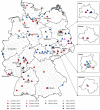Spread of West Nile Virus and Usutu Virus in the German Bird Population, 2019-2020
- PMID: 35456857
- PMCID: PMC9030481
- DOI: 10.3390/microorganisms10040807
Spread of West Nile Virus and Usutu Virus in the German Bird Population, 2019-2020
Abstract
West Nile virus (WNV) and Usutu virus (USUV) are important flaviviruses circulating in Germany. While USUV was first reported more than 10 years ago, WNV has only reached the country in 2018. Wild birds are important amplifying hosts for both viruses. Therefore, we have been monitoring the bird population in different regions of Germany by a previously established network for many years. This report summarizes the results of molecular and/or serological methods of 2345 blood samples from birds of 22 different orders and over 2900 bird carcasses from 2019 and 2020. USUV RNA circulation was found in different regions of Germany, with emphasis on USUV lineages Europe 3 and Africa 3. Increased evidence of USUV lineage Europe 2 was detected in eastern Germany. WNV RNA was found only in birds from the eastern part of the country. The seroprevalence for USUV was between 3.11% and 7.20% in all three regions investigated, whereas the WNV seroprevalence spanned from 14.77% to 16.15% in eastern Germany, with a noticeable tendency for a westward and southward expansion in both years. Thus, wild bird monitoring for WNV and USUV can serve as an early warning system for a human exposure risk.
Keywords: Germany; Usutu virus; West Nile virus; bird; flavivirus; monitoring.
Conflict of interest statement
The authors declare no conflict of interest.
Figures






References
-
- Vilibic-Cavlek T., Savic V., Petrovic T., Toplak I., Barbic L., Petric D., Tabain I., Hrnjakovic-Cvjetkovic I., Bogdanic M., Klobucar A., et al. Emerging Trends in the Epidemiology of West Nile and Usutu Virus Infections in Southern Europe. Front. Vet. Sci. 2019;6:437. doi: 10.3389/fvets.2019.00437. - DOI - PMC - PubMed
Grants and funding
LinkOut - more resources
Full Text Sources

